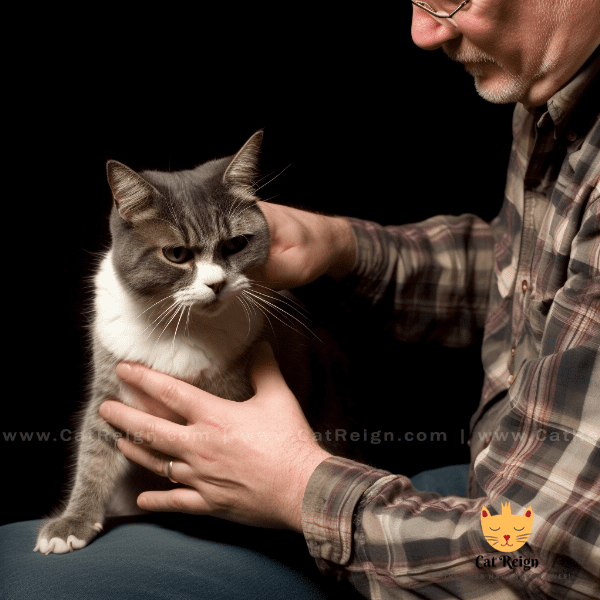Table of Contents
- Understanding the Reasons for Kitten Scratching
- Providing Proper Scratching Surfaces
- Using Positive Reinforcement Techniques
- Discouraging Undesirable Scratching Behaviors
- Consistency in Training and Correction
- Addressing Health Issues that may Contribute to Scratching
- Distracting Your Kitten from Scratching Inappropriate Surfaces
- Incorporating Playtime and Exercise to Reduce Scratching
- Seeking Professional Help for Severe Scratching Behaviors
- Maintaining a Happy and Healthy Relationship with Your Kitten.
Understanding the Reasons for Kitten Scratching
Scratching is a natural behavior for kittens and cats. It is a way for them to stretch their muscles, mark their territory, and maintain their claws. However, it can also be a destructive behavior, damaging furniture, carpets, and other household items. Therefore, it is essential to understand why your kitten is scratching and what you can do to train them to scratch in appropriate areas.
Instinctual Behaviors
Scratching is an instinctual behavior for kittens. They have an innate need to scratch, which helps them develop their muscles and release energy. In addition, scratching is a way for them to mark their territory. Cats have scent glands in their paws, so scratching is a way for them to leave their scent and communicate with other cats. Understanding that scratching is a natural behavior for your kitten will help you approach the training process with patience and understanding.
Boredom and Anxiety
Kittens may also scratch out of boredom or anxiety. If they are not provided with enough mental and physical stimulation, they may resort to destructive behaviors such as scratching. Similarly, if they are anxious or stressed, they may scratch as a way to relieve their tension. Identifying the underlying cause of your kitten’s scratching behavior is crucial in developing an effective training plan.
Developmental Stages
Kittens go through developmental stages where they may be more prone to scratching. When their claws are developing, they may need to scratch more to help shed their old claws and allow new ones to grow. Additionally, kittens may be more curious and exploratory during certain stages, which can lead to more scratching behaviors. Understanding your kitten’s developmental stage can help you anticipate their scratching behavior and train them accordingly.
In conclusion, understanding the reasons for your kitten’s scratching behavior is the first step in training them to scratch in appropriate areas. Scratching is a natural behavior for cats, but it can also be a destructive one. By identifying the underlying causes of your kitten’s scratching, you can develop a training plan that will help them develop healthy scratching habits.
 Kitten scratching”>
Kitten scratching”>Providing Proper Scratching Surfaces
One of the most effective ways to train your kitten to scratch in appropriate areas is to provide them with proper scratching surfaces. This will not only satisfy their natural scratching instincts but also prevent them from damaging your furniture and household items.
Types of Scratching Surfaces
There are several types of scratching surfaces that you can provide for your kitten. Scratching posts, cardboard scratching pads, and sisal rope scratching surfaces are popular choices. Scratching posts come in various sizes and shapes, and you can choose one that fits your kitten’s size and preferences. Cardboard scratching pads are affordable and can be easily replaced. Sisal rope scratching surfaces are durable and can withstand heavy scratching.
Placement of Scratching Surfaces
The placement of your kitten’s scratching surfaces is also important. They should be placed in areas where your kitten likes to scratch or where they spend the most time. For example, if your kitten likes to scratch near a window, you can place a scratching post near the window. If your kitten spends most of their time in the living room, you can place a scratching post in that area.
Encouraging Use of Scratching Surfaces
Encouraging your kitten to use their scratching surfaces is essential in training them to scratch in appropriate areas. You can do this by placing treats or toys on the scratching surfaces, using catnip to attract them, and gently guiding their paws to the scratching surface. Positive reinforcement, such as praise and treats, can also encourage them to use the scratching surfaces.
In conclusion, providing proper scratching surfaces is crucial in training your kitten to scratch in appropriate areas. There are various types of scratching surfaces, and you should choose one that fits your kitten’s size and preferences. Placing the scratching surfaces in areas where your kitten likes to scratch and encouraging their use with positive reinforcement can also help them develop healthy scratching habits.
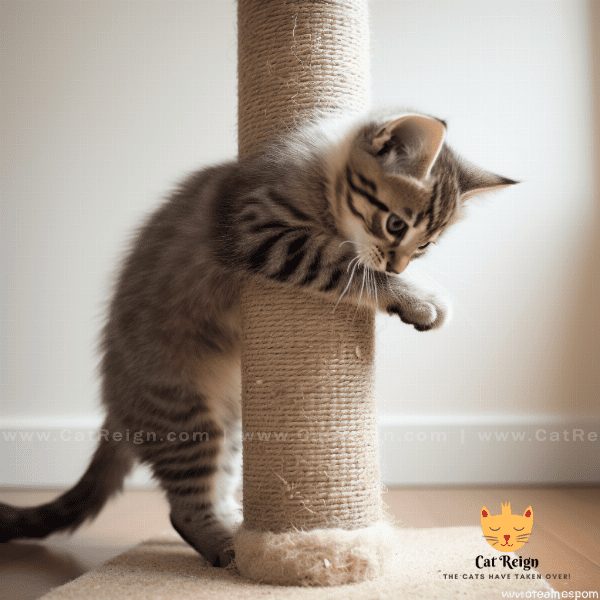
Using Positive Reinforcement Techniques
Rewards for Desirable Behaviors
Rewards are an effective way to reinforce desirable behaviors. When your kitten uses their scratching surfaces, you can offer them treats or toys as a reward. Verbal praise and affection can also be effective rewards. Consistent and immediate rewards will reinforce the desired behavior and increase the likelihood of your kitten using their scratching surfaces.
Ignoring or Redirecting Undesirable Behaviors
Ignoring or redirecting undesirable behaviors is also an important part of positive reinforcement. When your kitten scratches inappropriate surfaces, you should avoid punishing or scolding them. Instead, simply ignore the behavior or redirect their attention to an appropriate scratching surface. For example, if your kitten is scratching the couch, you can gently pick them up and place them on their scratching post. This will teach them that scratching inappropriate surfaces does not lead to rewards or attention.
Consistency in Positive Reinforcement
Consistency is key in positive reinforcement training. You should consistently reward desirable behaviors and ignore or redirect undesirable behaviors. This will help your kitten learn what behaviors are expected of them and what behaviors are not. Inconsistency in training can confuse your kitten and make it harder for them to learn.
In conclusion, positive reinforcement is a powerful tool in training your kitten to scratch in appropriate areas. Rewards for desirable behaviors and ignoring or redirecting undesirable behaviors can help your kitten associate scratching with positive experiences. Consistency in positive reinforcement training is important in teaching your kitten what behaviors are expected of them.

Discouraging Undesirable Scratching Behaviors
While positive reinforcement is effective in encouraging desirable scratching behaviors, it is also important to discourage undesirable scratching behaviors. This involves redirecting your kitten’s attention away from inappropriate scratching surfaces and discouraging them from using those surfaces in the future.
Using Deterrents
There are several deterrents that you can use to discourage your kitten from scratching inappropriate surfaces. Double-sided tape, aluminum foil, and citrus-scented sprays are effective deterrents. You can place double-sided tape or aluminum foil on the surfaces where your kitten likes to scratch. The texture and sound of these materials will discourage your kitten from scratching. Citrus-scented sprays can also be used as a deterrent, as cats generally do not like the scent of citrus.
Providing Alternative Surfaces
Providing alternative scratching surfaces can also help discourage your kitten from scratching inappropriate surfaces. If your kitten likes to scratch the couch, you can place a scratching post or pad near the couch. This will redirect their attention to an appropriate scratching surface. You can also move their favorite scratching surfaces to areas where they are more likely to scratch inappropriate surfaces.
Avoiding Physical Punishment
Physical punishment should be avoided when discouraging undesirable scratching behaviors. Physical punishment can be harmful and can lead to fear and anxiety in your kitten. Instead, use positive reinforcement techniques to redirect their attention to appropriate scratching surfaces.
In conclusion, discouraging undesirable scratching behaviors is an important part of training your kitten to scratch in appropriate areas. Using deterrents, providing alternative scratching surfaces, and avoiding physical punishment can help redirect your kitten’s attention away from inappropriate surfaces. Remember to use positive reinforcement techniques to encourage desirable scratching behaviors.
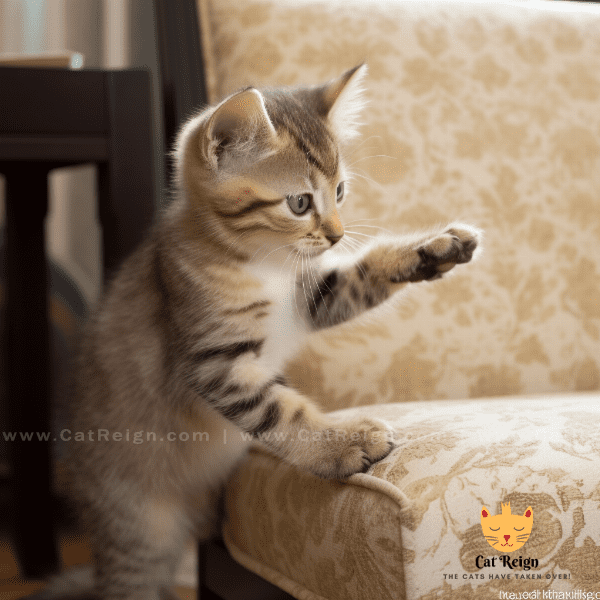
Consistency in Training and Correction
Consistency is crucial in training your kitten to scratch in appropriate areas. Consistent training and correction will help your kitten understand what behaviors are expected of them and what behaviors are not. This involves establishing a routine and consistently enforcing rules.
Establishing a Routine
Establishing a routine is important in training your kitten to scratch in appropriate areas. This includes providing them with proper scratching surfaces, rewarding desirable scratching behaviors, and redirecting or discouraging undesirable behaviors. Consistently following a routine will help your kitten understand what is expected of them and what behaviors are not acceptable.
Enforcing Rules
Enforcing rules is also important in training your kitten to scratch in appropriate areas. This involves consistently correcting them when they scratch inappropriate surfaces and rewarding them when they use appropriate scratching surfaces. It is important to be patient and consistent in enforcing rules. If you are inconsistent or do not enforce rules, your kitten may become confused and revert to undesirable scratching behaviors.
Using the Same Commands
Using the same commands is another way to maintain consistency in training and correction. For example, if you use the command “no” to discourage your kitten from scratching inappropriate surfaces, make sure to use the same command every time. Consistency in commands will help your kitten associate the command with the behavior and understand what is expected of them.
In conclusion, consistency in training and correction is essential in training your kitten to scratch in appropriate areas. Establishing a routine, enforcing rules, and using the same commands will help your kitten understand what behaviors are expected of them. Remember to be patient and consistent in your training and correction methods.
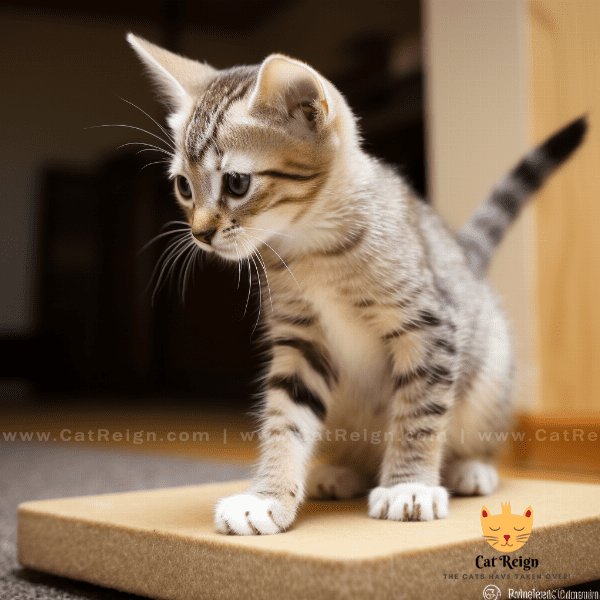
Addressing Health Issues that may Contribute to Scratching
Sometimes, health issues can contribute to your kitten’s scratching behavior. Identifying and addressing these issues can help reduce their scratching and improve their overall health and well-being.
Fleas and Other Parasites
Fleas and other parasites can cause itching and discomfort in your kitten, leading to excessive scratching. Regular flea and parasite prevention can help reduce the likelihood of your kitten developing these issues. If you suspect that your kitten has fleas or other parasites, consult with your veterinarian for appropriate treatment.
Skin Conditions
Skin conditions, such as allergies or infections, can also cause itching and scratching. These conditions can be caused by a variety of factors, including diet, environmental allergens, and genetics. If you suspect that your kitten has a skin condition, consult with your veterinarian for appropriate diagnosis and treatment.
Anxiety and Stress
Anxiety and stress can also contribute to your kitten’s scratching behavior. If your kitten is anxious or stressed, they may resort to scratching as a way to relieve their tension. Identifying the underlying cause of your kitten’s anxiety or stress and addressing it can help reduce their scratching behavior. Consult with your veterinarian or a professional animal behaviorist for appropriate guidance.
Pain and Discomfort
Pain and discomfort can also contribute to your kitten’s scratching behavior. For example, if they have a paw injury or arthritis, they may scratch as a way to relieve their discomfort. Identifying and addressing the underlying health issue can help reduce their scratching behavior. Consult with your veterinarian for appropriate diagnosis and treatment.
In conclusion, addressing health issues that may contribute to your kitten’s scratching behavior is essential in reducing their scratching and improving their overall health and well-being. Fleas and other parasites, skin conditions, anxiety and stress, and pain and discomfort can all contribute to scratching behavior. If you suspect that your kitten has a health issue, consult with your veterinarian for appropriate diagnosis and treatment.

Distracting Your Kitten from Scratching Inappropriate Surfaces
When your kitten starts scratching inappropriate surfaces, it is important to distract them and redirect their attention to appropriate scratching surfaces. This involves using toys, treats, and other distractions to encourage them to use their scratching posts or pads.
Interactive Toys
Interactive toys can be a great way to distract your kitten from scratching inappropriate surfaces. Toys that encourage play and exercise, such as balls, string toys, and laser pointers, can help redirect your kitten’s attention to appropriate scratching surfaces. Playing with your kitten and their toys can also help strengthen your bond and increase their motivation to use appropriate scratching surfaces.
Treats and Food Puzzles
Treats and food puzzles can also be effective distractions for your kitten. Treats can be used as rewards for using appropriate scratching surfaces, and food puzzles can encourage your kitten to spend time in their scratching area. Interactive food puzzles, such as treat-dispensing balls or mats, can provide mental stimulation and encourage your kitten to use their scratching surfaces.
Environmental Enrichment
Environmental enrichment can also help distract your kitten from scratching inappropriate surfaces. Providing them with climbing structures, hiding places, and window perches can provide mental stimulation and encourage them to explore their environment. This can also help reduce their boredom and anxiety, which can contribute to scratching behavior.
In conclusion, distracting your kitten from scratching inappropriate surfaces is an important part of training them to scratch in appropriate areas. Interactive toys, treats and food puzzles, and environmental enrichment can all be effective distractions. Remember to use positive reinforcement techniques to encourage desirable scratching behaviors and be patient and consistent in your training methods.

Incorporating Playtime and Exercise to Reduce Scratching
Playtime and exercise are important for your kitten’s physical and mental health, and can also help reduce their scratching behavior. Regular playtime and exercise can provide your kitten with an outlet for their energy and reduce their boredom and anxiety.
Interactive Play
Interactive play is an effective way to engage your kitten and reduce their scratching behavior. Playing with your kitten using toys, such as string toys or feather wands, can provide physical and mental stimulation and redirect their energy away from scratching inappropriate surfaces. Interactive play can also help strengthen your bond with your kitten and increase their motivation to use appropriate scratching surfaces.
Physical Exercise
Physical exercise is also important for your kitten’s health and can help reduce their scratching behavior. Providing them with climbing structures, such as scratching posts or cat trees, can encourage them to climb and jump, providing physical exercise and mental stimulation. You can also provide them with toys that encourage running and chasing, such as balls or toy mice.
Mental Stimulation
Mental stimulation is also important for your kitten’s well-being and can help reduce their scratching behavior. Puzzle toys and treat dispensers can provide mental stimulation and encourage your kitten to spend time in their scratching area. You can also provide them with hiding places and window perches to encourage exploration and mental stimulation.
In conclusion, incorporating playtime and exercise into your kitten’s routine is important for their physical and mental health, and can help reduce their scratching behavior. Interactive play, physical exercise, and mental stimulation can all be effective in reducing boredom and anxiety and redirecting your kitten’s energy away from inappropriate scratching surfaces. Remember to use positive reinforcement techniques to encourage desirable scratching behaviors and be patient and consistent in your training methods.
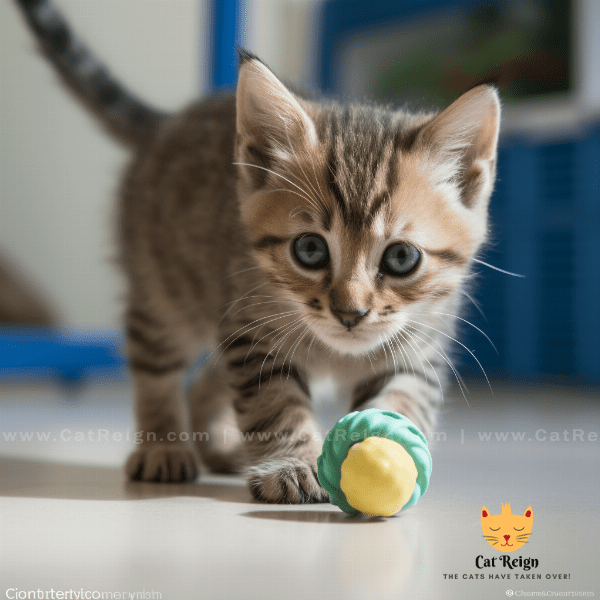
Seeking Professional Help for Severe Scratching Behaviors
In some cases, your kitten’s scratching behavior may be severe or persistent, despite your best efforts to train and correct them. If this is the case, seeking professional help may be necessary to address the issue and improve your kitten’s well-being.
Consulting with Your Veterinarian
Your veterinarian can help identify underlying health issues that may be contributing to your kitten’s scratching behavior. They can also provide guidance on appropriate treatment options, such as medications or specialized diets, to address these issues.
Consulting with an Animal Behaviorist
An animal behaviorist can help identify the underlying causes of your kitten’s scratching behavior and provide guidance on appropriate training and correction methods. They can also provide guidance on environmental enrichment and other strategies to reduce your kitten’s anxiety and boredom.
Considering Medication
In some cases, medication may be necessary to address your kitten’s severe scratching behavior. Your veterinarian or animal behaviorist can prescribe medication to reduce anxiety, depression, or other underlying issues that may be contributing to their scratching behavior.
In conclusion, if your kitten’s scratching behavior is severe or persistent, seeking professional help may be necessary to address the issue and improve their well-being. Consulting with your veterinarian or an animal behaviorist, and considering medication if necessary, can help identify and address underlying issues and reduce your kitten’s scratching behavior. Remember to be patient and consistent in your training methods, and use positive reinforcement techniques to encourage desirable scratching behaviors.
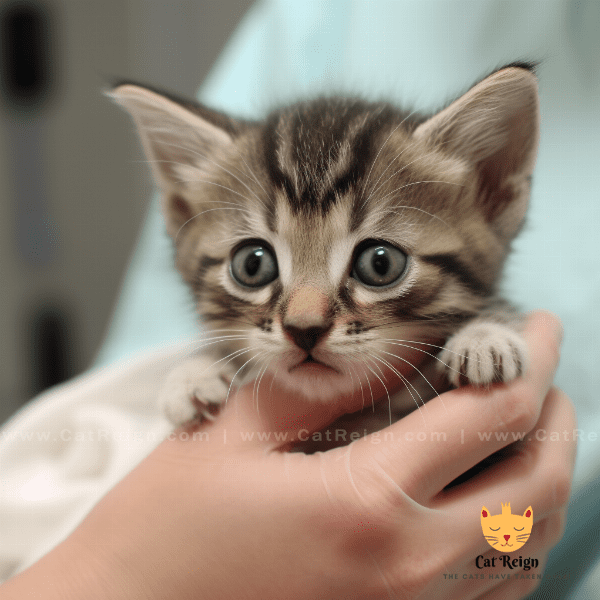
Maintaining a Happy and Healthy Relationship with Your Kitten.
Training your kitten to scratch in appropriate areas is important for their well-being, but it is also important to maintain a happy and healthy relationship with them. This involves providing them with affection, attention, and proper care.
Affection and Attention
Providing your kitten with affection and attention is important for their emotional well-being. This includes petting them, playing with them, and spending quality time with them. Providing your kitten with a warm and loving environment can also help reduce their anxiety and boredom, which can contribute to scratching behavior.
Proper Care
Providing your kitten with proper care is also important for their physical and emotional well-being. This includes providing them with proper nutrition, regular veterinary checkups, and a clean and safe living environment. Regular grooming can also help reduce their scratching behavior by removing excess hair and reducing the likelihood of skin irritation.
Positive Reinforcement
Using positive reinforcement techniques, such as treats and praise, can also help maintain a happy and healthy relationship with your kitten. This involves rewarding desirable behaviors, such as using appropriate scratching surfaces, and avoiding punishment or negative reinforcement.
In conclusion, maintaining a happy and healthy relationship with your kitten is important for their well-being and can also help reduce their scratching behavior. Providing them with affection and attention, proper care, and positive reinforcement can help create a warm and loving environment for your kitten. Remember to be patient and consistent in your training methods, and seek professional help if necessary to address severe scratching behavior.



